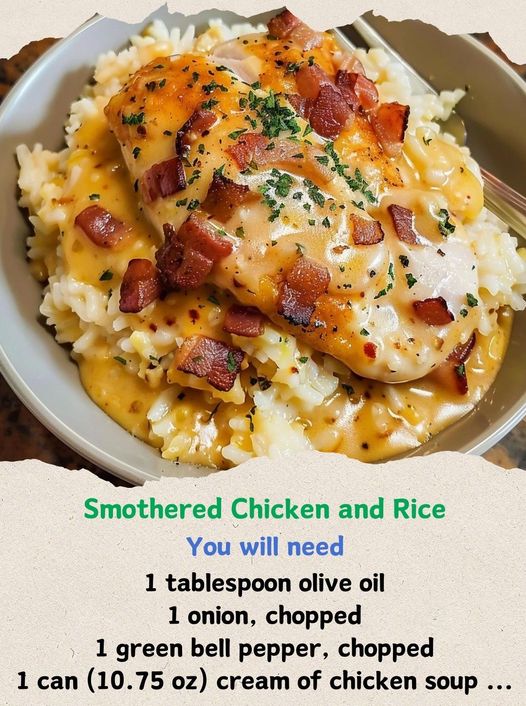
Smothered chicken and rice is a comforting, hearty dish that brings the warmth of home-cooked meals to the table. The dish combines tender chicken breasts, flavorful vegetables, creamy sauces, and perfectly cooked rice. Each bite delivers a satisfying blend of rich, savory flavors that make it a family favorite. Smothered in a combination of soups and seasonings, this dish offers a creamy and indulgent texture, ideal for those who seek comfort food that’s easy to prepare and delicious.
Why It’s Popular
This dish is a staple in many households because it is quick to assemble, requires minimal ingredients, and can be made in one pan. Smothered chicken and rice is perfect for busy weeknights, allowing families to enjoy a wholesome meal without spending too much time in the kitchen. The convenience of using pantry staples, such as cream of chicken soup, cream of mushroom soup, and long-grain rice, adds to its popularity. It’s also versatile, allowing for easy ingredient substitutions and customization based on personal preferences.
Brief History of the Dish
The roots of smothered chicken can be traced back to Southern cuisine, where the technique of “smothering” meats in rich sauces has long been a tradition. In many cultures, rice is a primary staple, and combining it with savory chicken dishes enhances both flavor and nutrition. Over time, this dish evolved to include modern conveniences like canned soups, making it a beloved part of American comfort food culture.
Ingredients Breakdown
Boneless, Skinless Chicken Breasts
Boneless, skinless chicken breasts are often used because they cook quickly, are lean, and absorb the flavors of the sauce well. They are widely available and easy to prepare. However, chicken thighs or bone-in chicken can also be used for a richer, juicier taste. Thighs have more fat content, which adds depth to the dish, while bone-in pieces can provide more flavor during cooking.
Olive Oil
Olive oil is used for browning the chicken. It not only helps in creating a nice crust on the meat but also adds healthy fats. Olive oil has a relatively high smoke point and a neutral flavor, which makes it ideal for searing chicken and sautéing vegetables.
Onion and Green Bell Pepper
These vegetables add flavor and texture to the dish. Onion provides a sweet, savory base, while green bell pepper contributes a mild, slightly bitter taste. Together, they create a flavorful foundation that complements the creamy sauce.
Cream of Chicken Soup
This ingredient brings a smooth, creamy texture to the dish. It enhances the chicken flavor, making the sauce richer and more indulgent. Cream of chicken soup also thickens the sauce, creating a hearty consistency.
Cream of Mushroom Soup
The cream of mushroom soup adds depth with its earthy flavors, providing balance to the richness of the cream of chicken. It brings complexity to the sauce and complements the overall flavor profile.
Chicken Broth
Chicken broth is essential for adding moisture and a savory punch. It helps cook the rice while keeping the dish moist and flavorful.
Long-Grain White Rice
Long-grain rice is ideal for this dish because it maintains its structure during baking. It absorbs the flavors of the broth and soups without becoming mushy. Alternatives like brown rice can be used, but they may require a longer cooking time.
Seasoning (Salt, Pepper, Garlic Powder, Paprika)
These seasonings elevate the flavors of the dish. Salt and pepper are essential for balancing the taste, while garlic powder adds a robust, savory depth. Paprika not only adds a subtle smoky flavor but also gives the chicken a beautiful golden color when browned.
Step-by-Step Instructions
Step 1: Preheat the Oven
Preheating the oven to 350°F (175°C) ensures that the dish cooks evenly. A properly heated oven is crucial for allowing the rice to absorb the liquid and the chicken to cook through without drying out. Preheating also helps the flavors meld together as the dish bakes.
Step 2: Browning the Chicken
Browning the chicken in olive oil is a critical step for flavor. By searing the chicken for 2-3 minutes on each side, you lock in the juices and create a caramelized crust, which enhances the overall taste of the dish. It also gives the chicken a golden appearance and adds complexity to the dish.
Step 3: Sautéing Vegetables
After removing the chicken, sauté the chopped onion and green bell pepper in the same skillet. Cooking them for about 5 minutes until they soften allows them to release their natural sweetness, which enhances the flavors in the final dish. The leftover bits from browning the chicken also infuse the vegetables with additional flavor.
Step 4: Preparing the Soup and Rice Mixture
In a bowl, mix the cream of chicken soup, cream of mushroom soup, and chicken broth. Stir in the uncooked long-grain white rice, ensuring that everything is evenly combined. This mixture will provide moisture and flavor to both the chicken and the rice as they cook together in the oven.

- Save
Step 5: Assembling the Dish
Layer the sautéed vegetables at the bottom of a baking dish, followed by placing the browned chicken breasts on top. Pour the soup and rice mixture over the chicken. This layering ensures that the flavors are evenly distributed throughout the dish and that the rice cooks properly in the liquid.
Step 6: Baking Time
Cover the baking dish with aluminum foil and bake for about 60 minutes. The foil traps moisture, helping the rice absorb the liquid and cook evenly. During this time, the chicken will cook through, and the creamy sauce will thicken.
Step 7: Final Touches
After 60 minutes, check the dish for doneness. The rice should be tender, and the chicken should reach an internal temperature of 165°F (74°C). You can add optional garnishes like freshly chopped parsley or thyme for an extra pop of color and flavor.
Nutritional Information and Serving Suggestions
Nutritional Breakdown
Smothered chicken and rice is a balanced meal that provides protein, carbohydrates, and fats. A single serving typically contains around 400-500 calories, depending on portion size and specific ingredients used. Chicken breasts are a lean source of protein, while the rice provides energy from carbohydrates. The dish is higher in fat due to the use of cream-based soups, but olive oil adds healthy fats. You can reduce sodium levels by using low-sodium chicken broth and soups.
Serving Size
This recipe yields approximately four servings, with each serving containing one chicken breast and a generous portion of rice and vegetables. For larger gatherings, you can easily double the recipe.
Side Dish Pairings
To round out the meal, consider serving smothered chicken and rice with complementary side dishes. Fresh green beans or steamed broccoli add a nice contrast with their crispness. For a Southern-inspired meal, pair it with buttery cornbread or a simple garden salad to add a fresh, light component to balance the richness of the dish.
Customization Options
Vegetable Substitutions
Smothered chicken and rice is highly customizable when it comes to vegetables. Mushrooms are an excellent addition, adding an earthy flavor that complements the creamy sauce. Zucchini offers a mild taste and soft texture that works well in baked dishes, while carrots bring sweetness and vibrant color. You can mix and match these vegetables based on personal preference or what’s in season. Each substitution enhances the dish’s nutrition and can give it a unique twist.
Rice Variations
While long-grain white rice is commonly used for its ability to remain fluffy and absorb flavors well, you can experiment with other rice types. Wild rice offers a nutty flavor and chewy texture, adding complexity to the dish, though it may require more liquid and a longer baking time. Basmati rice has a fragrant aroma and cooks faster, making it an option for those who want a slightly quicker meal. Brown rice is a healthier, fiber-rich choice, but it takes longer to cook, so you may need to increase the broth and extend the baking time.
Spice Variations
Changing up the spices can elevate the dish in different directions. Add thyme or rosemary for an herby note, or smoked paprika for a deep, smoky flavor. If you prefer more heat, a pinch of cayenne pepper or red pepper flakes can give the dish a nice kick. Fresh herbs like parsley or cilantro can also be sprinkled on top after baking for added freshness.
Healthier Options
For a lighter version, you can substitute low-sodium chicken broth and use light cream soups to reduce the sodium and fat content. Skinless chicken thighs are another great alternative, offering a leaner cut of meat while still remaining juicy and flavorful.
Common Mistakes and How to Avoid Them
Undercooking or Overcooking the Chicken
One of the most common issues is undercooking or overcooking the chicken. To avoid this, always check the internal temperature of the chicken with a meat thermometer. The chicken should reach an internal temperature of 165°F (74°C). To prevent overcooking, don’t leave the dish in the oven for too long after the chicken has reached the proper temperature, as the residual heat will continue to cook the meat.
Rice Still Crunchy
If the rice is still crunchy after the baking time, it’s likely that it didn’t absorb enough liquid. This can happen if the foil was not tightly sealed or if there wasn’t enough broth. A quick fix is to add more liquid—chicken broth or water—and cover the dish again, then continue baking until the rice is tender. Be sure to keep the dish covered throughout the cooking process to trap steam, which is crucial for the rice to cook fully.
Dry or Overly Thick Sauce
A dry or overly thick sauce can ruin the texture of the dish. If you notice the sauce is too thick before baking, simply add more chicken broth to loosen it. If the sauce becomes dry during baking, adding a bit of broth halfway through the cooking process can prevent it from thickening too much. Keeping the dish covered with foil also helps retain moisture.
Overpowering or Bland Flavor
If the dish tastes too bland or overpowering, adjusting the seasoning is key. For more flavor, add extra salt, pepper, or spices like garlic powder or thyme. If the dish is too rich or salty, a squeeze of fresh lemon juice can brighten the flavors and balance the heaviness of the sauce.
Tips for Making Smothered Chicken Ahead of Time
Make-Ahead Options
This dish is great for prepping ahead of time. You can fully assemble the dish up to 24 hours in advance and store it in the refrigerator, covered with foil. When you’re ready to cook, simply place it in the preheated oven, but allow an additional 10-15 minutes of baking time if the dish is cold from the fridge. This allows everything to heat through evenly.
Freezing Instructions
Smothered chicken and rice also freezes well. After assembling the dish but before baking, cover it tightly with both plastic wrap and aluminum foil to prevent freezer burn. It can be frozen for up to 3 months. When ready to bake, thaw the dish in the refrigerator overnight, then bake as directed. If baking from frozen, you’ll need to increase the cooking time by 30-40 minutes, checking that the internal temperature of the chicken reaches 165°F (74°C).


